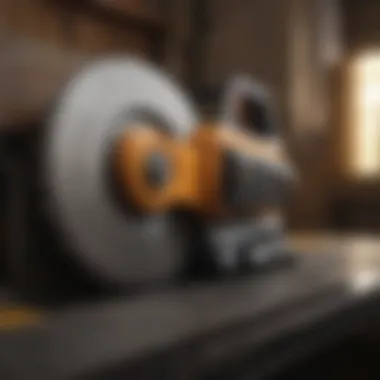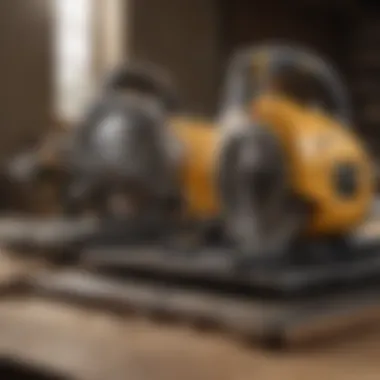Top Rated Skill Saws: A Detailed Review and Comparison


Intro
In the ever-evolving landscape of home improvement, few tools stand out quite like skill saws. These saws are not just a convenience; they are an essential asset for anyone looking to tackle both large-scale projects and small repairs around the house. Whether you are a seasoned professional or a hobbyist, understanding the nuances of skill saws can significantly impact your efficiency and craftsmanship.
Skill saws, also known as circular saws, have cemented their reputation for versatility, enabling users to cut through various materials with precision. They offer a powerful blend of functionality and portability, making them indispensable for both indoor renovations and outdoor constructions. Homeowners often underestimate the importance of selecting the right skill saw, which is where this article comes into play. We will delve deep into the features that differentiate one saw from another, ensuring you make a choice that aligns with your specific needs.
Moreover, it’s imperative to grasp the significance of mastering these tools. Using a skill saw effectively can mean the difference between a project completed flawlessly and a struggle fraught with mistakes and subpar finishes. Proper knowledge of safety protocols, maintenance practices, and operational techniques transforms a skill saw from a mere tool into an ally in your home improvement journey.
Prelude to Skill Saws
Skill saws, a vital tool in any homeowner's or DIY enthusiast's arsenal, play an essential role in crafting, remodeling, and repairing. The importance of this section lies not only in demystifying the intricate world of skill saws but also in helping novices and experienced users alike appreciate their functionalities and impact on projects. By understanding the core aspects of skill saws—their definition, purpose, and evolution—we can navigate the myriad choices available on the market today. This knowledge empowers users to select the right saw that aligns with their specific needs, ensuring safety and efficiency without breaking the bank.
Definition and Purpose
A skill saw refers to a circular saw that is most commonly used in woodworking and construction. To put it simply, it’s a power tool that features a toothed or abrasive disc or blade that spins around an arbor, cutting through various materials such as wood, plastic, and even metal when equipped with the right blade. The versatility of skill saws makes them indispensable for a multitude of tasks—from ripping large sheets of plywood to crosscutting small pieces of timber.
Skill saws excel in providing precise cuts, which is vital for ensuring a clean finish in any project. Whether you’re a weekend warrior tackling home improvements or a commercial carpenter managing intricate builds, the right skill saw can vastly improve your cutting power, saving time and effort while enhancing the professional look of your work.
Evolution of Skill Saws
The journey of skill saws dates back to the 19th century, where the first iterations were hand-operated, making it quite a labor-intensive affair. Fast forward to today, and you have electric skill saws that are designed for maximum efficiency and ease of use. The early electric models emerged in the 1920s, offering significant advancements in power and precision.
As technology progressed, so did design improvements. Early models were bulky and less user-friendly, whereas modern skill saws boast lightweight materials, ergonomic designs, and improved safety features. In recent years, battery-powered skill saws have gained popularity. These cordless options provide extra mobility, freeing users from the constraints of a power outlet, thus removing any potential tripping hazards at busy job sites.
The evolution of skill saws also includes enhancements in blade technology, offering users an array of choices suitable for diverse materials and cutting styles. This means that, today, one can find saws specifically designed for intricate cuts or heavy-duty applications—catering to hobbies and professions alike.
Key Features of Skill Saws
Understanding the key features of skill saws is paramount when selecting the right tool for your needs. Each feature has its own significance, shaping performance and usability in ways that can either make or break a project's success. From how the motor delivers power to the types of blades available and the cutting depth, these elements collectively determine how well a skill saw will function in various scenarios. This section illuminates the critical components of skill saws, equipping readers with the knowledge needed to choose wisely, whether for professional use or DIY projects at home.
Motor Power
The motor power of a skill saw serves as its heart; it dictates not just how well the saw can cut through materials but also affects user experience significantly. Most skill saws come with power ratings measured in amps or watts, and a stronger motor generally means the ability to tackle denser and tougher materials. For instance, a saw with a 15-amp motor may slice through hardwood without breaking a sweat, while those with less power might struggle and stall, leaving you frustrated halfway through a cut.
Moreover, an efficient motor can also prolong the life of both the tool and the blades. When the motor has adequate power, it creates less strain, reducing wear and tear. In short, motor power is essential for ensuring that the skill saw not only performs well but does so consistently and reliably. For housewives and homeowners, it allows for flexibility in the types of projects you can undertake, from simple craftwork to more demanding renovation tasks.
Blade Type and Material
The blade of a skill saw plays a pivotal role in the quality of the cut. Blade types can vary significantly—from carbide-tipped blades to high-speed steel options—and each serves different purposes. For example, a carbide-tipped blade retains its sharpness longer than steel, making it a worthwhile investment for those who use their saw regularly.
Different materials also dictate how the saw performs; steel blades are often best for softwoods, while carbide blades shine when cutting through tougher materials such as plywood or laminates.
Additionally, the number of teeth on the blade impacts the finish of the cut. More teeth generally yield smoother cuts, while fewer teeth provide quicker, rougher cuts due to increased space between the teeth. So, understanding your material needs and desired finish can directly influence your choice of blade, making it a critical aspect of skill saw selection. Householders who are keen on doing a variety of crafting or home improvement tasks should pay particular attention to blade types and materials.
Cutting Depth and Capacity
Cutting depth and capacity is where a skill saw truly proves its worth. This feature determines the thickness of materials that can be effectively sliced through, be it plywood for a crafts project or a thicker plank for a building job. Most skill saws feature adjustable cutting depths, which means you can set the saw to the height that best suits your material's thickness, ensuring a clean cut.
A saw with a maximum cutting depth of 2.5 inches, for example, is ideal for most home-related tasks, enabling access to plank sizes and layered materials easily. Meanwhile, those who are looking into more heavy-duty projects may want to eye saws with greater capacity since they become essential for woodworking or construction.
In summary, the importance of understanding cutting depth and capacity cannot be overstated; it directly influences how versatile the skill saw can be in different projects. Those investing in a skill saw would benefit from knowing what thicknesses they plan to work with, thus ensuring their tool meets future demands.
"Selecting the right skill saw isn't just about what feels good in hand; it's about what meets your project's unique needs."
Safety Considerations
Safety considerations while using skill saws cannot be overstated. These powerful tools are incredibly useful for various cutting tasks, but with that utility also comes risk. Ensuring that both users and their surroundings are safe is paramount. Skill saws can cause serious injury if not handled correctly, making awareness of safety elements and best practices essential.
By integrating protective features into saw design, manufacturers aim to reduce potential accidents. However, safety also lies in the hands of the user. Knowledge of how to operate skill saws safely can go a long way in preventing mishaps.
Protective Features
When evaluating skill saws, it's essential to pay attention to the protective features they include. These elements are specifically designed to keep users safe while maximizing efficiency. Common protective features include:
- Blade Guards: These are designed to cover the saw blade when not in use. They automatically retract when the saw is activated, providing a crucial barrier.
- Electric Brake: A feature that stops the blade almost immediately when the trigger is released, minimizing the risk of accidental cuts.
- Anti-Kickback Technology: This feature helps prevent the saw from jerking backward if the blade binds while cutting, thus offering better control during operations.
- Ergonomic Design: Many models come with handles that provide a better grip, reducing hand fatigue and allowing for more precise control, especially during lengthy projects.
These protective features not only enhance user safety but also improve overall confidence. A well-designed skill saw allows the user to focus on the task at hand rather than worry about potential accidents.
"The best tool is one that empowers users to create while keeping them safe."
User Safety Practices
Alongside built-in safety features, user practices are critical in ensuring safe operations. Understanding how to properly handle and use a skill saw contributes greatly to reducing risks. Here are a few key safety practices to consider:
- Wear Appropriate Gear: Always don safety glasses, gloves, and hearing protection when using a skill saw.
- Inspect the Tool Before Use: Check for damage to the blade, power cord, and body of the saw. A small defect can lead to major incidents.
- Secure the Workpiece: Make sure the material you are cutting is securely clamped or held. This prevents any movement that could lead to injury.
- Maintain a Clean Workspace: Keep the area around the saw free of clutter. Debris or obstacles can lead to trips and falls.
- Follow the Manufacturer's Instructions: Each saw may have specific guidelines on usage. Familiarize yourself with these to ensure the tool is operated safely.


By following these user safety practices, the risks associated with skill saw usage can be greatly minimized. The combination of protective features and conscientious operation creates a safer working environment for everyone involved.
Reviews of Top Skill Saws
When diving into skill saws, the reviews often draw a line between solid choices and flashy gimmicks. Understanding the reviews of top skill saws is essential in distinguishing which models genuinely stand out and which ones are merely riding the wave of popularity. These reviews synthesize insights from users who have hands-on experience, which often leads to valuable information about performance, ease of use, and the durability of the tools in everyday scenarios.
In particular, these reviews address several key elements, including:
- Performance Metrics: Speed, cutting depth, and material capabilities determine how well a skill saw can perform over time.
- User Experience: Individual feedback reveals not just operational efficiency but also comfort and safety aspects during prolonged use.
- Long-term Reliability: Understanding how a tool holds up after continuous use is crucial for both the amateur woodworker and the professional craftsman.
- Price vs Performance: Evaluating the cost relative to the quality and features can lead users to make more prudent decisions.
In short, the importance of these reviews lies in their role as a compass, guiding potential buyers towards tools that will serve their user requirements without breaking the bank.
Brand A Model
Performance Overview
Brand A's Model X is a hot topic of discussion among skill saw enthusiasts. This model boasts a state-of-the-art motor capable of 5,000 RPM, allowing for seamless cuts across multiple wood types. The precision in its design plays a notable role in enhancing productivity, giving users confidence in their cuts. One unique feature is its built-in laser guide, which shifts the game for accurate alignment, making it a popular choice for those tackling intricate projects.
However, some users mention that the powerful motor leads to higher vibrations, which could be a bother during finer work. It’s a characteristic that should be weighed against its advantages.
User Feedback
User feedback on Model X has been largely positive, with many praising its balance and light weight, making it a breeze to maneuver. Reviewers consistently highlight the ease of blade replacement as a significant convenience, a feature that many don't always consider until they need to change the blade. This flexibility is a common thread in user reviews, reinforcing its reputation as a reliable option for both newcomers and seasoned users.
Yet, on the flip side, some feedback notes that the compact design may not accommodate larger hands comfortably, potentially affecting prolonged usage.
Pros and Cons
In the world of skill saws, Brand A Model X comes with notable pros:
- High RPM for fast cutting
- Lightweight construction for ease of use
- Built-in laser guide enhances precision
But it's not without its drawbacks:
- Higher vibration levels could affect fine cuts
- Design may be uncomfortable for larger hands
Brand B Model Y
Performance Overview
Shifting focus to Brand B's Model Y, one cannot ignore its unique selling proposition—a robust 6.5-amp motor that brings immense power while maintaining control. The cutting depth reaches up to 2.5 inches, which is advantageous for users requiring more from their tool. Unlike some competitors, this model features a patented cooling system that prevents overheating, ensuring prolonged usage without compromising performance.
Nevertheless, some users have expressed concerns about its heavier weight, making it less suitable for overhead tasks.
User Feedback
Feedback surrounding Model Y emphasizes its durability and consistent performance, particularly in commercial settings where heavy use is the norm. Users appreciate its solid build, which stands up to the rigors of frequent job site demands. The automatic brake feature has also been well-received, adding a layer of safety that resonates with users.
However, the bulkiness is a widely mentioned downside, indicating potential fatigue during long projects. This aspect can deter DIY enthusiasts who prefer lighter tools for home usage.
Pros and Cons
When diving into its pros, one can note:
- Highly durable for long-term use
- Powerful cooling system prevents overheating
- Safety features enhance user security
But, as always, it has its cons:
- Heavier weight can cause fatigue
- Higher price point compared to some alternatives
Brand Model Z
Performance Overview
Brand C's Model Z conveys a blend of power and portability, making it popular in many circles. With a variable speed control up to 5,300 RPM, users can tailor their approach to meet specific cutting needs. Plus, the ergonomic design showcases a comfort grip that reduces fatigue, even on extended tasks—a crucial point for any serious woodworker.
On the downside, some reviews touch on the sound level, indicating it might be on the louder side, which can be considered a concern for residential use.
User Feedback
User feedback on Model Z highlights its adaptability and versatility. Many folks appreciate how easy it is to transition between different tasks without requiring extensive adjustments. Those who frequently shift between mediums, like plywood to hardwood, find this particularly appealing. The positive mentions around the integrated dust blower also show concern for cleanliness during operation.
However, a few users reported that the dust collection isn’t as effective as advertised, leading to a bit of mess during use.
Pros and Cons
Model Z stands strong with pros like:


- Adaptable for multiple cutting scenarios
- Comfortable design reduces user fatigue
- Integrated dust blower for cleaner operation
Yet, it carries its cons:
- Potential noise concerns for residential users
- Less effective dust collection than expected
Comparative Analysis
In the realm of power tools, a comparative analysis serves as a vital compass for navigating the sea of options available to consumers. Engaging in this type of analysis empowers homeowners and DIY enthusiasts to sift through features, pinpoint what truly matters, and ultimately make a choice that resonates with their needs. Through careful consideration of various models, the reader can effectively weigh attributes like power output, blade types, and ergonomic designs, all of which contribute to the practicality and usability of skill saws.
This analysis doesn't merely focus on the bells and whistles; it provides a structured way to understand why certain features outperform others. A comprehensive result isn't simply about picking the most expensive or the most popular model; it's about finding the saw that speaks to the intended use. This differentiation is essential when considering the varying skill levels of users, ranging from seasoned professionals to suburban homeowners looking to tackle home improvement projects.
For example, a homeowner might find a particular model boasts high motor power but lacks user-friendly features like adjustable cutting depths. In contrast, a different saw may come equipped with advanced safety features, perfect for those who prioritize ease of use and safety. Thus, comparative analysis sheds light on how these elements play into the overall functionality of the tool, ultimately assisting users in selecting the saw that aligns with both their abilities and project requirements.
"A good analysis doesn’t headline the price; it highlights what you pay for."
Feature Comparison
Delving into feature comparison lends clarity to the decision-making process. Key characteristics such as motor power, blade type, and cutting capacity can differ significantly across models. For instance, a lightweight saw might offer portability but may fall short on torque, while a heavier model could provide robust power at the cost of ease of handling.
Common features to compare include:
- Motor power: Measures output in amps or horsepower, directly affecting cutting efficiency.
- Blade type and material: Different blades offer varied performance based on the material being cut.
- Cutting depth: The ability to adjust cutting depth is vital for diverse applications.
Homeowners and professionals must assess what they are cutting most frequently—wood, metal, or composite materials. This evaluation can guide them toward a blade that thrives in those conditions, minimizing the need for frequent replacements.
Price Point Analysis
When it comes to price points, a closer look unveils the real story behind the numbers. While it’s easy to judge a tool's value by its price tag, hidden costs often lurk in the shadows. This aspect makes price point analysis critical in understanding what you’re actually spending money on.
Value isn’t merely about the upfront cost; it's about longevity, warranty, and the potential for repairs. Some lower-priced models may require frequent replacement parts or offer shorter warranty periods, while a more expensive saw might hold its value longer, providing dependable performance over years.
Key considerations in price point analysis include:
- Initial cost vs. longevity: Will a higher investment translate to a longer-lasting tool?
- User experience: Cheaper models may feel flimsy, impacting overall satisfaction.
- Cost of accessories: Certain models necessitate specialized blades that can be pricey.
In this light, it becomes crucial for the homeowner or DIY enthusiast to create a budget that reflects not just immediate purchases, but also long-term investments in their tools.
This comprehensive approach to analyzing both features and price ensures that users can step into any hardware store with the confidence it takes to make informed, effective decisions.
User Preferences
User preferences play a pivotal role in the decision-making process when it comes to selecting the best-rated skill saws. Every user, whether a seasoned professional or a casual DIYer, has distinct needs and priorities that guide their choice. Understanding these preferences can significantly influence satisfaction with the tool's performance and its ability to meet the user's specific requirements.
Choosing a skill saw is not merely about functionality; it also involves considerations such as comfort, weight, design, and features tailored to individual tasks. This section delves into those preferences, spotlighting their impacts on user experience.
Professional Reviews
Professional reviews are invaluable for discerning the best options available in the market. Experts in the field bring in-depth knowledge and hands-on experience when evaluating skill saws, allowing readers to gain insights that are often more profound than unfiltered user reviews. These seasoned professionals take into account factors like durability, design efficiency, and suitability for various applications.
For instance, a professional contractor might highlight how the weight of a saw influences maneuverability on a job site. A lighter model can allow for extended use without tiring the hands, especially in overhead applications. On the flip side, pros might also tout the benefits of heftier saws that offer enhanced stability during operation.
Key elements that often emerge in professional reviews include:
- Power and Performance: A discussion about the saw's motor strength and its capacity to make deep and precise cuts.
- Ergonomics: How comfortable the tool feels to use over extended periods without causing strain.
- Reliability: Insights into the longevity and dependability of the saw under constant use.
- Advanced Features: An objective review of any extra features such as laser guides, kickback protection, or dust collection mechanisms.
"In the hands of a skilled user, the right skill saw can be the difference between a job well done and one that needs fixing. It's not about the brand; it's about finding the one that fits your style of work."
DIY Enthusiast Insights
Conversely, insights from DIY enthusiasts offer a different angle on the usage of skill saws. This group usually values user-friendliness, ease of set-up, and affordability more than the high-end features sought by professionals. For many weekend warriors, a skill saw serves as an introduction to woodworking or home improvement, making accessibility and simplicity paramount.
Enthusiasts often share their experiences about how certain features resonate with their project types. For example, a user might praise a saw's lightweight design that allows ease of transport for home projects or renovations. Others could focus on blade swaps, where the ease of changing blades becomes a crucial factor, particularly for those demanding versatility in their saws.
Moreover, community forums and social media groups, such as those on Reddit or Facebook, allow DIYers to share tips, hacks, and even personal stories about their skills saw journeys. These platforms fuel a collective of shared knowledge, revealing common preferences that might inform potential buyers.
Considerations from DIY users include:
- Price Points: Finding a balance between quality and cost without feeling financially strained.
- Customer Support & Warranty: The assurance that their tool comes with solid support in case of breakdowns or issues.
- Ease of Operation: How intuitive the tool is for those who may not have extensive training or experience.
Understanding both professional reviews and DIY insights lays the groundwork for a comprehensive grasp of user preferences. These diverse perspectives equip readers with the necessary information to sift through options and ultimately make an informed choice that aligns with their personal or professional needs.
Environmental Impact of Skill Saws
The impact skill saws have on the environment is an important aspect to consider, especially today when ecological awareness is on the rise. A tool used in various construction and DIY projects naturally raises questions about its footprint—both for the planet and for our communities. This section will closely examine sustainability concerns and energy efficiency related to skill saws, providing valuable insights that can guide not just purchasing decisions but also responsible usage.
Sustainability Concerns


When discussing skill saws, sustainability refers to how these tools are manufactured, utilized, and ultimately disposed of. The production of any power tool often comes with considerable resource consumption and waste generation. Many skill saw manufacturers are recognizing the importance of responsible sourcing and are moving towards more sustainable practices.
Key considerations include:
- Material sourcing: What raw materials are used in the saw’s production? Manufacturers are now more frequently opting for recycled or sustainably-sourced materials in their tools.
- Longevity and durability: A skill saw that lasts longer reduces the need for replacements. A solid build is essential not just for performance but also to minimize environmental impact in the long run.
- Disposal and recyclability: How do consumers dispose of their old skill saws? Understanding if a product can be recycled or repurposed is crucial to reducing waste.
There’s an increasing demand from homeowners and professionals alike for tools that don’t just perform well but also reflect a commitment to sustainability. Buying a product from a brand that prioritizes eco-friendly practices paints a picture of a consumer who values the environment.
"Investing in environmentally-friendly skill saws not only benefits the planet but can also lead to cost savings in energy and waste management over time."
Energy Efficiency
Energy efficiency is another pressing matter when exploring the environmental impact of skill saws. Tools that operate with high energy efficiency contribute greatly to reducing a homeowner's carbon footprint. Today, many manufacturers are focusing on enhancing the energy-saving capabilities of their products.
Key points to consider include:
- Motor design: Skill saws equipped with brushless motors often offer better energy efficiency. They manage to deliver the same power using less electricity, making them an attractive option for energy-minded users.
- Power settings: Many modern skill saws come with adjustable power settings, allowing the user to choose the amount of energy needed for different tasks. This feature, while enhancing versatility, also translates to energy savings.
- Battery technology: With the rise of cordless skill saws, advancements in battery technology—like lithium-ion—help improve energy efficiency. These batteries last longer and can be charged faster, significantly lowering the energy consumed per cut.
As the tools are put to use, their efficiency not only aids in reducing utility bills but also plays a part in a bigger picture—minimizing greenhouse gas emissions.
In summary, the environmental implications of skill saws extend beyond immediate use to encompass production, disposal, and energy consumption. By prioritizing sustainability and efficiency, we can help cultivate a planet that's not just usable but thriving.
Maintenance and Care
When it comes to skill saws, maintenance and care are not simply options; they are essential practices that can significantly affect the longevity and performance of these tools. A well-cared-for skill saw not only functions better but also ensures safety during operation. Neglecting maintenance can lead to reduced efficiency, greater wear and tear, and even potential accidents. Homeowners and DIY enthusiasts alike should consider routine maintenance a vital part of their toolkit, as it extends the life of the saw, enhances its cutting performance, and ultimately saves money in the long run.
Routine Maintenance Practices
To keep your skill saw in peak condition, embracing a routine maintenance schedule is key. Here are some practices you can adopt:
- Blade Cleaning: After each use, wipe down the blade to remove sawdust, resin, and other debris. This can prevent buildup that affects cutting efficiency. A clean blade cuts better and stays sharper longer.
- Lubrication: Many skill saws have moving parts that benefit from proper lubrication. Check the user manual to find out the right lubricant and intervals for applying it. This reduces friction and wear.
- Tension Checks: Ensure that the blade is properly tensioned. A loose blade can wobble during use, compromising safety and accuracy. Periodically check and adjust as needed.
- Cord Inspection: For corded models, inspect the power cord regularly for frays or damage. A damaged cord can be a safety hazard and may cause electrical failures.
- Storage Practices: Store your skill saw in a dry and secure location, preferably in a case or a toolbox to protect it from dust and moisture.
Troubleshooting Common Issues
Every skill saw, at some point, may present issues that can hinder its performance. Here are some common problems and their troubleshooting techniques:
- Blade Not Cutting: If the saw isn't cutting effectively, it may be time for a new blade. Check if the blade is sharp; a dull blade can make cutting a frustrating task.
- Excessive Vibration: This could indicate that the blade is not mounted correctly or is damaged. Turn off the saw and inspect the blade installation. Ensure it is secure and not warped.
- Power Issues: If the saw won’t turn on, check the power source. For corded saws, try a different outlet. For battery-operated models, ensure the battery is charged and properly connected.
- Chattering Noise: A saw might chatter during operation when the blade is either dull or there’s an issue with alignment. Confirm the blade is sharp and check the alignment settings.
- Overheating: If the saw overheats, allow it to cool down. Continuous running without breaks can lead to overheating. Make sure to give the saw time between prolonged use.
By performing regular maintenance and being attentive to common issues, users can ensure that their skill saw will continue to operate smoothly and safely, getting the most out of this invaluable tool.
Future Trends in Skill Saw Technology
As technology continues evolving, the world of skill saws is not left behind. Understanding the future trends in this domain is vital for both seasoned professionals and home improvement enthusiasts. With the crafting landscape progressively embracing advancements, the integration of new technology into skill saw design signifies a shift towards achieving greater precision, efficiency, and user experience. Not only do these innovations promise enhanced performance, but they also address some age-old safety concerns that plague traditional power tools. This exploration digs into two significant trends: automation and smart technology, as well as materials and design innovations.
Automation and Smart Technology
Automation is changing the way we approach almost every task, including woodwork and construction. Smart technology, in particular, plays a critical role in improving the user experience with skill saws. Integrated features like laser guides and digital displays make it easier than ever for the user to achieve precise cuts. A laser guide, for example, projects a line onto the material being cut, ensuring accuracy without the need for constant measuring. This automation not only saves time but also minimizes errors, which is particularly beneficial for novice users who may not yet have mastered the art of cutting.
Moreover, some advanced models are incorporating features like real-time feedback on cutting angles and speeds. This direct communication with the saw allows users to adapt their techniques in real-time, which is a game changer for those tackling complex projects.
Benefits include:
- Increased precision: Reducing the margin of error leads to better overall results in projects.
- User-friendly experience: Less experienced users can produce professional-quality work.
- Higher safety standards: Features like automatic brake systems activate in dangerous situations, protecting users from potential injuries.
Materials and Design Innovations
When it comes to materials, weight, durability, and ease of use are paramount. This is where design innovations stride in. Manufacturers are increasingly focusing on lightweight materials without sacrificing durability. For instance, the emergence of carbon fiber and special aluminum alloys is shaping the future saw designs, making them easier to handle without compromising on robustness.
Additionally, ergonomics is a consideration that is receiving greater attention. The design of handles and grips can significantly affect user comfort during prolonged usage. Skill saws are increasingly featuring contoured grips that fit snugly in the user’s hands, reducing fatigue and allowing for more extended use without discomfort.
In summary, these innovations bring forth several benefits:
- Lighter weight: Makes handling easier and reduces the physical strain on users.
- Enhanced efficiency: New designs that streamline cutting processes save valuable time.
- Higher productivity: Comfortable designs allow for longer work sessions without deterioration of performance.
As we continue to embrace new technologies and materials, one thing is clear: the skill saws of tomorrow will not only offer superior performance but will also foster a safer and more intuitive working environment.
"In the quest for excellence in craftsmanship, innovation is a tool as critical as the instrument itself."
Embracing these future trends ensures that woodworkers and hobbyists alike can navigate their projects with ease and, ultimately, reap the rewards of their labor.
Ending
The concluding section of this article serves as a vital anchor, consolidating the rich information gathered throughout. The essence of the skill saws discussed establishes not only their capabilities but also emphasizes user preferences that vary significantly among individuals. Understanding the different models and features allows both the seasoned woodworker and the occasional DIYer to navigate the sometimes murky waters of options on the market today.
Moreover, this part of the text aims to synthesize all that has been explored, honing in on how these tools can significantly enhance the woodworking experience. It’s crucial to recognize that the right skill saw could mean the difference between a project that feels like a breeze and one mired in frustration. Therefore, a well-informed decision can yield benefits such as improved productivity, better finishes, and an overall more enjoyable experience.
Considerations regarding safety, maintenance, and technological evolution also play a substantial role in concluding thoughts. A discerning buyer needs to weigh not only the immediate requirements but also long-term functionality, energy efficiency, and potential for future upgrades. When you step back and analyze the broader implications of choosing the perfect skill saw, it’s about more than just the price tag or brand reputation. It’s about investing in a tool that will empower you to achieve remarkable outcomes in your projects, ensuring both satisfaction and safety.
Key Takeaways
- Informed Decision-Making: Armed with knowledge about various models and their functionalities, users can select a saw that aligns perfectly with their projects.
- Enhanced Productivity: Choosing the right skill saw leads to greater efficiency, allowing you to get the job done with less hassle.
- Safety First: The importance of safety features cannot be overstated. Prioritizing tools designed with user safety in mind is essential.
- Future-Proofing: As technology advances, investing in skill saws that can adapt to new tools and enhancements ensures longevity and relevance in your toolkit.
- User Preferences Matter: Acknowledging that user feedback reflects real-world usage offers valuable insights that textbooks may overlook.
Ultimately, the final thoughts encapsulate the journey through this article, underscoring how each piece of information plays a role in crafting a well-rounded understanding of skill saws.







